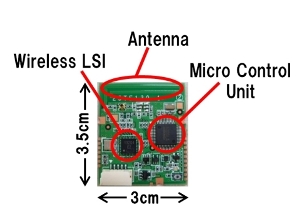Mar 29 2014
Panasonic Corporation today announced that it has developed a new wireless communication technology for M2M (Machine-to-Machine) sensor networks[1], where devices communicate with each other in an autonomous way without human intervention.
 Prototype Module employing Developed Wireless Technologies (Photo: Business Wire)
Prototype Module employing Developed Wireless Technologies (Photo: Business Wire)
This technology is based on a single chip of LSI that can simultaneously detect multiple wireless communication standards, which differ from one country to another or in the target applications. Multiple communication modes are integrated by sharing the software of same functions and reducing the amount of signal processing in microcomputer. As a result, engineers can design and develop wireless modules that are small but can operate for an extended period of time. The newly-developed technology makes it easier to connect disparate devices and helps accelerate the spread of wireless sensor networks[2], contributing to achieving a society with a safe, secure, convenient and comfortable living environment.
Currently, different modes of wireless communication are used in different countries and regions for connecting devices to sensor networks. The new multi-mode wireless communication technology integrates multiple receiver circuits required for each individual wireless mode into a single one, enabling devices to be connected easily and stably each other regardless of operation frequencies and wireless standards. With a smaller area, the same as the receiving part of conventional single-mode wireless chip, multi-mode wireless LSI can support up to three different wireless modes at a time. The new LSI helps create a small and power-saving wireless module that will continue to operate for around 20 years on the battery.*2
The new technology has the following features.
- Ability to be used in various devices and/or machines, independent of wireless standards and operation frequencies.
- Reduction in the receiver power consumption of the whole module by 55% (compared with Panasonic’s existing products) that enables 20-year battery operation*2.
- A small multi-mode wireless LSI having the same size as a conventional single-mode one, enabling downsizing of wireless modules.
This multi-mode wireless communication technology includes the following technologies.
- Multi-mode technology that reduces both power consumption and memory capacity requirement based on frequency detection by hardware and unified control by common software for multiple wireless operation modes.
- Receiver power reducing technology that enables 20-year battery operation while supporting multiple wireless modes, which is achieved by intelligently controlling voltage supplies and generating high rate internal clocks from low rate clocks to minimize circuit current.
- Wireless LSI miniaturizing technology which reduces the size of coils in oscillator circuits and eliminates filters used in analog-to-digital converters.
Panasonic holds 26 Japanese patents and 19 overseas patents (including pending) related to this technology.
Development of this technology was supported in part by the "Research and Development for Expansion of Radio Spectrum Resources" program of The Ministry of Internal Affairs and Communications, Japan. A field test starts today at The ICT Incubation Laboratory in Research Center for Advanced Science and Technology, the University of Tokyo.
Notes:
*1: As of March 28, 2014, according to Panasonic data.
*2: When used in a smart meter or HEMS child device and receives and transmits information every 30 seconds using a 1200mAh industrial-use lithium-ion battery.